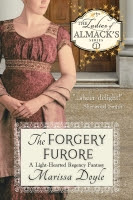Life, alas, has not been easy
this week; those of you who have elderly parents and are involved in their care
know that sometimes everything else needs to be laid aside. All I can do is
offer my apologies, beg your indulgence, and promise to return next week with
more of the usual. In the meanwhile, may I offer a blast from the past,
appropriate in these days of early evening-fall?
- - -
It’s early evening as I write this and getting a little dim in my
office...so just now I leaned forward and with a small movement of my
hand turned on the lamp on my desk. Lovely, clear light now floods this
part of the room, strong enough to read by several feet away.
Electricity—it’s a beautiful thing. Had this been 1813 rather than 2013,
I would have had to do a great deal more to achieve this amount of
light.
In the early 19th century, light came from fire. Period. That fire might flicker and bounce at the end of a candle—perhaps a tallow candle made from sheep or beef fat, which tended to smoke and sputter, could lend an odor of eau de barnyard
to a room, and not give forth very much light. Tallow candles required
snuffing—that is, their wicks had to periodically be trimmed as the
candles burned in order for the candle to burn properly—with snuffers,
which looked like an odd pair of scissors (see image above).
Or it might shine from a more expensive beeswax candle and provide a much steadier, longer-lasting light that didn’t require snuffing and smelled much more pleasant than a sheepy tallow candle.
Candles might sit in holders on a table or desk, singly or in many-branched candelabras. Or they might be in sconces attached to the wall, perhaps with a plate of polished metal or a mirror to reflect and increase the light they gave. Or they might perch in a chandelier (from the French word for candle) and give light from above...but alas, also drip on people and objects below them.
However, candles were expensive and heavily taxed—one pence a pound for tallow candles, 3 ½ pence a pound for beeswax. So for the very poorest, their light might come from rushlights—basically a rush (a marsh plant) dipped in drippings or some other greasy substance—that could be made for free, but didn’t provide much illumination.
Or the fire that was giving you light might come from an oil lamp, in its most basic form consisting of a chamber to hold some type of oil and a wick that served to draw up the oil and burn...but by the 19th century had grown fairly sophisticated, with special holders to lengthen and shorten the wick and so provide more or less light. Plant oils like olive oil and palm oil might be used, but whale oil was probably the most popular oil for lighting—not only in houses, but in businesses, theaters, and on the streets, where lamplighters made their rounds every evening and morning to light and then extinguish streetlamps.








No comments:
Post a Comment